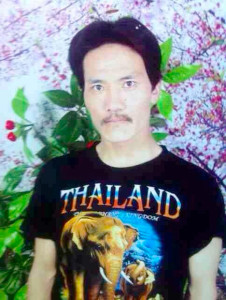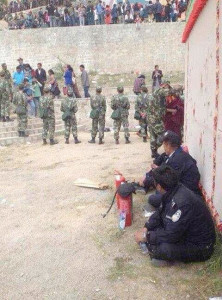 Shichung, who set fire to himself and died on September 28, 2013.  The site of Shichung’s self-immolation in Gomang, Ngaba, showing police with fire extinguishers and troops. |
A Tibetan father of two set fire to himself and died yesterday (September 28) in Gomang village, Ngaba (Chinese: Aba) county, according to exile Tibetan sources. When Tibetans gathered around his body, police aimed their guns at the crowd. Village elders averted tensions by appealing to both local Tibetans and police for calm.
Forty-year old Shichung set himself on fire outside his house and ran along the road shouting in protest against the Chinese authorities before he collapsed to the ground in flames and died, according to Kirti monks in exile in Dharamsala. The monks said before he self-immolated, he lit a butter-lamp before an image of the Dalai Lama. A few days earlier, he had said, “The Chinese will never leave us in peace”, according to the same sources.
Following his self-immolation, although local people recovered the body for prayers at first, police then took Shichung’s corpse. Police presence in the area is being stepped up and there are fears of increasing tensions.
Shichung was the 122nd Tibetan to set fire to himself since the wave of self-immolations across Tibet began in February, 2009, in Ngaba Tbetan and Qiang Autonomous Prefecture, Sichuan (the Tibetan area of Amdo). (ICT, Self-immolations by Tibetans). The last self-immolation was on July 20, of an 18-year old monk called Kunchok Sonam outside his monastery in Dzoege, also in Ngaba, where the crackdown has been among the most intense in Tibetan areas.
Shichung, who was from a farming family, was a skilled tailor, who made clothes in the local Tibetan style and sold them at public gatherings such as religious festivals, according to the sources. He leaves behind his wife, an 18-year old daughter and son, 14.
Gomang village in Ngaba, where Shichung lived and died, has been subject to intensified repression since 2008, when a wave of protests swept across Tibet. In February, 2009, monk Tapey from Kirti monastery in Ngaba became the first Tibetan to set fire to himself in Tibet. On March 16, 2011, a 20-year old monk named Phuntsog died after setting fire to himself in a protest held on the third anniversary of a protest at Kirti in 2008 during which at least 10 Tibetans were shot dead.
On June 16, 2008, monks at Gomang monastery – which is around 13 kilometers from the county town of Ngaba – protested against an attempt by police and government officials to raise a Chinese flag on the top of the monastery building. According to a Gomang monk who is now in exile, “The monks rose in protest against the action, and broke the lock of the newly constructed police station in the monastery compound, and stopped the flag from being hoisted. By the time the flag was taken down, the police officers and government officials had left the monastery.” (Tibetan Center for Human Rights and Democracy report).
A year later, in March, 2009, Gomang monks began a peaceful march towards Ngaba county town calling for the long life of the Dalai Lama and for a free Tibet before they were stopped by security forces (reported by the exile Tibetan online portal phayul.com, Monks of Ngaba Gomang monastery protest, 1 held – March 7, 2009).
The Gomang monk in exile, 25-year old Lobsang Tsephel, told the Tibetan Center for Human Rights and Democracy that: “Since July 2010, four officials from the State Security Bureau have been living permanently in Gomang Monastery. Since their arrival, monks who come under official suspicion are being detained for two to three months or for a few days of interrogation. After the crackdown in 2008, the population of Gomang Monastery has been reduced to 370 from over 900.”

